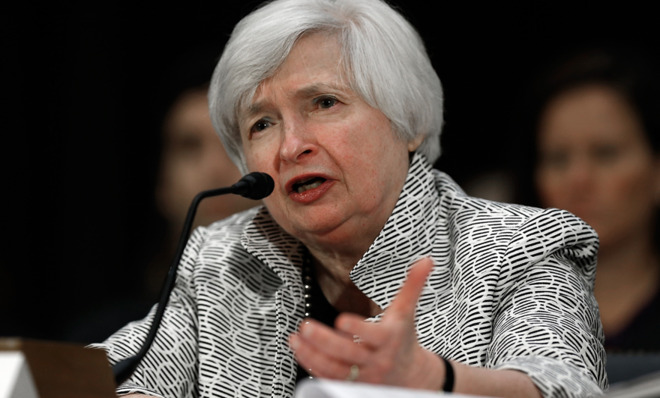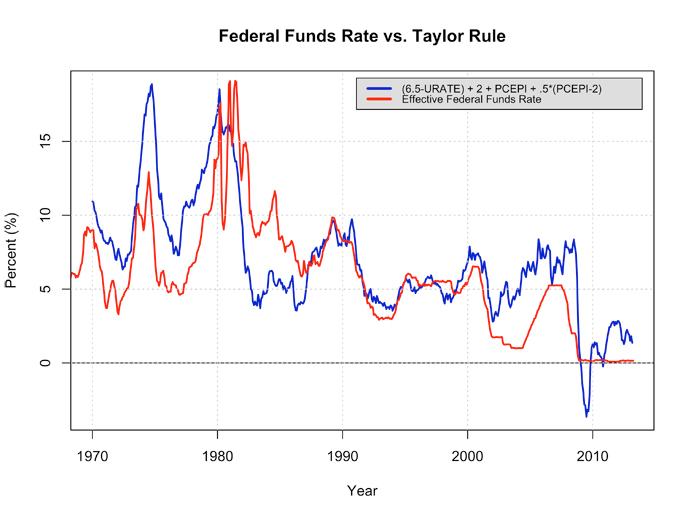The GOP's latest brainwave for the Federal Reserve is another terrible idea
Monetary policy can't be reduced to an equation

House Republicans Scott Garrett (R-N.J.) and Bill Huizenga (R-Mich.) last month introduced a bill to force the Federal Reserve to adopt the so-called Taylor rule, an algorithm for determining interest rates developed by Stanford University economist John B. Taylor.
It's the latest in a long line of Republican attempts to reform the Fed, from former presidential candidate Ron Paul's desire to abolish it outright to Rep. Kevin Brady's (R-Texas) stab at rewriting its goal to include only low inflation and not low unemployment.
Taylor's rule states that the interest rate that the Fed sets — the so-called federal funds rate — should equate to what Taylor calls the neutral real interest rate (set at 2 percent) plus inflation, plus the gap between inflation and a target rate (again set to 2 percent), plus the difference between nominal and potential GDP.
The Week
Escape your echo chamber. Get the facts behind the news, plus analysis from multiple perspectives.

Sign up for The Week's Free Newsletters
From our morning news briefing to a weekly Good News Newsletter, get the best of The Week delivered directly to your inbox.
From our morning news briefing to a weekly Good News Newsletter, get the best of The Week delivered directly to your inbox.
If that seems complicated, what it really boils down to is that the Taylor rule would have resulted in a pretty similar interest rate policy over the last 40 years to what the Fed actually delivered, with two key exceptions:

First, the Taylor rule would have resulted in a negative interest rate during the 2008 financial crisis. This is basically impossible under the current monetary system because you can't lower interest rates below the zero percent that one receives by simply holding cash. So even if you were to assume that the Taylor rule is the best system for assessing what interest rates should be, the Fed does not (currently) have the tools to use it fully.
But second, the Taylor rule would have made the Fed begin raising interest rates above zero as early as 2010. Given that the economic recovery has been relatively slow and difficult, raising interest rates in 2010 — back when unemployment was as high as 9.9 percent — would have been a highly risky and potentially counterproductive move.
And even the one major advantage claimed by the Taylor rule's proponents — that the rule's consistency would lead to predictable monetary policy decisions — is false. Swedish economists Ulf Söderström, Anders Vredin, and Paul Söderlind found back in 2004 that "it is very hard to predict actual interest rate changes" under a Taylor rule regime, and concluded that "Taylor rules neglect important aspects of monetary policy behavior."
A free daily email with the biggest news stories of the day – and the best features from TheWeek.com
That's exactly the conclusion I would reach. The bigger problem is that there is more to monetary policy than just the few variables covered by Taylor's mathematical formula. Economies are big, dynamic systems, not just simple equations. That means monetary policymakers should be allowed to make policy in a dynamic way, responding to factors like unemployment, like wage growth, like industrial production, like business and consumer confidence, like geopolitics, energy shocks, fiscal policy, and the banking system.
Trying to constrain the Fed to just the few variables in the Taylor rule would leave it with its hands tied behind its back. In particular, cutting unemployment out of the Fed's mandate is just foolish. Mass unemployment is extremely dangerous because it often leads to civil unrest and economic turmoil, as the eurozone — whose central bank, the ECB, is tightly constrained to price stability — is currently discovering. The U.S. has succeeded since the financial crisis at lowering unemployment, yielding a much stronger economic recovery than the eurozone. Why would Republicans want to ape the ECB's failures?
John Aziz is the economics and business correspondent at TheWeek.com. He is also an associate editor at Pieria.co.uk. Previously his work has appeared on Business Insider, Zero Hedge, and Noahpinion.
-
 The Week Unwrapped: What’s the cost of PFAs?
The Week Unwrapped: What’s the cost of PFAs?Podcast Plus why is George Osborne joining OpenAI? And has universal basic income finally come of age?
-
 The week’s best photos
The week’s best photosIn Pictures A dervish dance off, a frosty forest, and more
-
 Mount Rainier is on its way down
Mount Rainier is on its way downUnder the radar Its peak elevation is approximately 20 feet lower than it once was